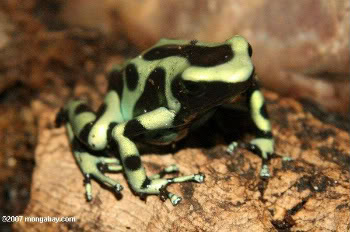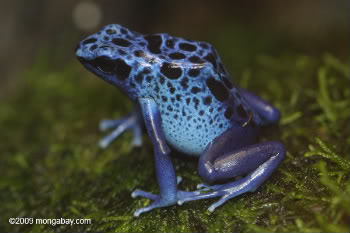Electric colors, wild markings, and toxic skin have made poison frogs well-known inhabitants of the Amazon rainforest. With 353 recognized species, and probably more awaiting discovery, poison frogs are an incredibly diverse group of amphibians. While it has long been believed that the Amazon basin, itself, was the source of their diversity, a new study published in PLoS Biology has uncovered that the Andes mountain chain has served as an oven of evolutionary biodiversity for poison frogs over several million years.
The study found that the diversity of poison frogs is due to at least fourteen dispersals of ancestral frogs into the Amazon basin, beginning about 23 million years ago. Eleven of these fourteen dispersals, or nearly 80 percent, came from the Andes.
 Green arrow frog. Photo by: Rhett A. Butler. |
“Basically, the Amazon basin is a ‘melting pot’ for South American frogs,” says Juan Santos, lead author of the study and graduate student at The University of Texas, Austin. “Poison frogs there have come from multiple places of origin, notably the Andes Mountains, over many millions of years. We have shown that you cannot understand Amazonian biodiversity by looking only in the basin. Adjacent regions have played a major role.”
Santos and Dr. David Cannatella, co-author and professor of integrative biology at the University of Texas at Austin, looked at DNA sequences to uncover the frogs’ evolutionary past, since the fossil record of tropical forests is sparse at best.
The researchers found that migration wasn’t only one way, i.e. From the Andes to the Amazon basin, but that many species have migrated out of the Amazon basin to other regions in the Neotropics.
 Blue poison dart frog. Photo by: Rhett A. Butler. |
Cannatella believes that poison frogs are probably not alone in having the Andes, and perhaps other regions, as sources of biodiversity, countering the long-held belief that the basin was the source of all of the diversity.
“The Amazon rainforest is not just gradually accumulating diversity over time,” says Dr. David Cannatella, co-author of the paper and professor of integrative biology. “Ancestral frog species moved into and out of the area, and we can predict that other organisms restricted to these wet tropical forests may show a similar pattern of dispersal, evolution and diversification.”
Amphibians globally, including the poison frogs of the Neotropics, are gravely threatened by habitat loss, pollution, invasive species, climate change, and a fungal disease chytridiomycosis, which has spread through the region like wildfire. Currently one third of amphibians are threatened with extinction and 200 species have vanished in just twenty years. Scientists have warned that time is running out to save the world’s amphibians.
Related articles
Amphibians face mass extinction
(08/11/2008)
Amphibians are in big trouble. At least one third of the world’s 6,300 known species are threatened with extinction, while at least 200 species have gone extinct over the past 20 years. Worryingly the outbreak of a deadly fungal disease, chytridiomycosis, is spreading throughout the tropics leaving millions of victims. A new study, published in the early edition of the Proceedings of the National Academy of Sciences, warns that there is “little time to stave off a potential mass extinction” of frogs, salamanders, and caecilians.
New poison frog species discovered in Colombia
(08/28/2007)
Scientists have discovered a previously unknown species of poison frog in a remote mountainous region in Colombia. The tiny frog has been dubbed the “golden frog of Supata” and lives only in a 20 hectare area in Colombia’s Cundinamarca region.
Why poison dart frogs are poisonous
(05/14/2007)
Mites — not ants as long believed — appear to be the primary source of toxins used by poison arrow frogs to defend against predators, reports new research published in the early online edition of Proceedings of the National Academy of Sciences (PNAS). Poison dart frogs, colorful amphibians with skin secretions so toxic that they are used by indigenous populations to poison the tips of hunting arrows, are one of several groups of animals capable of sequestering deadly compounds from dietary sources without being harmed. Until now, it was believed that ants were the primary source of these defensive skin alkaloids in frogs.
Frogs avoid damaging UV-B radiation, reducing extinction risk
(04/18/2007)
Poison arrow frogs appear to make special effort to avoid exposure to damaging ultraviolet-B radiation, according to research published in the journal Biotropica. The findings are significant in light of increasing levels of UV-B radiation due to ozone depletion.
Snake becomes poisonous by eating toxic frogs
(01/29/2007)
A new study shows that the Asian snake Rhabdophis tigrinus becomes poisonous by sequestering toxins from its prey which consists of venomous toads. While sequestering defensive toxins from prey is unusual among terrestrial vertebrates it is not unknown. Research published last year by Valerie C. Clark of Cornell University showed that poison dart frogs (Dendrobates species) and their Madagascar counterparts, the Mantella frogs, sequester toxic skin chemicals, called alkaloids, from the ants they eat. These alkaloids protect the frogs from predation. Similarly, some garter snakes are known to store tetrodotoxin from ingested newts while birds in New Guinea appear to sequester poisons from insects.
Convergent Evolution of Poison Frogs and Ants
(08/10/2005)
A steady diet of ants may have driven the convergent evolution of poisonous frogs in Madagascar and the Americas, researchers report.







